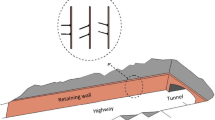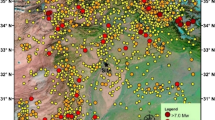Abstract
This is the second paper of two, which describe the results of an integrated research effort to develop a four-step simplified approach for design of raft foundations against dip-slip (normal and thrust) fault rupture. The first two steps dealing with fault rupture propagation in the free-field were presented in the companion paper. This paper develops an approximate analytical method to analyze soil-foundation-structure interaction (SFSI), involving two additional phenomena: (i) fault rupture diversion (Step 3); and (ii) modification of the vertical displacement profile (Step 4). For the first phenomenon (Step 3), an approximate energy-based approach is developed to estimate the diversion of a fault rupture due to presence of a raft foundation. The normalized critical load for complete diversion is shown to be a function of soil strength, coefficient of earth pressure at rest, bedrock depth, and the horizontal position of the foundation relative to the outcropping fault rupture. For the second phenomenon (Step 4), a heuristic approach is proposed, which “scans” through possible equilibrium positions to detect the one that best satisfies force and moment equilibrium. Thus, we account for the strong geometric nonlinearities that govern this interaction, such as uplifting and second order (P-Δ) effects. Comparisons with centrifuge-validated finite element analyses demonstrate the efficacy of the method. Its simplicity makes possible its utilization for preliminary design.
Similar content being viewed by others
References
Anastasopoulos I and Gazetas G (2007a), “Foundation-Structure Systems over a Rupturing Normal Fault: Part I. Observations After the Kocaeli 1999 Earthquake,” Bulletin of Earthquake Engineering, 5(3): 253–275.
Anastasopoulos I and Gazetas G (2007b), “Behaviour of Structure-Foundation Systems over a Rupturing Normal Fault: Part II. Analysis of the Kocaeli Case Histories,” Bulletin of Earthquake Engineering, 5(3): 277–301.
Anastasopoulos I, Gazetas G, Bransby MF, Davies MCR and El Nahas A (2007a), “Fault Rupture Propagation Through Sand: Finite Element Analysis and Validation Through Centrifuge Experiments,” Journal of Geotechnical and Geoenvironmental Engineering, 133(8): 943–958.
Anastasopoulos I, Gazetas G, Bransby MF, Davies MCR, and El Nahas A (2007b), “Normal Fault Rupture Interaction with Strip Foundations,” Journal of Geotechnical and Geoenvironmental Engineering (submitted for possible publication).
Anastasopoulos I, Gerolymos N, Gazetas G and Bransby MF (2008), “Simplified Approach for Design of Raft Foundations Against Fault Rupture. Part I: Free-field,” Earthquake Engineering and Engineering Vibration, 7(2)
Berill JB (1983), “Two-dimensional Analysis of the Effect of Fault Rupture on Buildings with Shallow Foundations,” Soil Dynamics and Earthquake Engineering, 2(3): 156–160.
Bransby MF, Davies MCR and El Nahas A (2007a), “Centrifuge Modelling of Normal Fault-Foundation Interaction,” Bulletin of Earthquake Engineering, Special Issue: Integrated Approach to Fault Rupture-and Soil-foundation Interaction, (submitted for possible publication).
Bransby MF, Davies MCR and El Nahas A (2007b), “Centrifuge Modelling of Reverse Fault-foundation Interaction,” Bulletin of Earthquake Engineering, Special Issue: Integrated Approach to Fault Rupture-and Soil-foundation Interaction, (submitted for possible publication).
Bray JD (2001), “Developing Mitigation Measures for the Hazards Associated with Earthquake Surface Fault Rupture,” Proceedings, Workshop on Seismic Fault-Induced Failures-Possible Remedies for Damage to Urban Facilities, Tokyo University Press, Tokyo, pp: 55–79.
Bray JD and Kelson KI (2006), “Observations of Surface Fault Rupture from the 1906 Earthquake in the Context of Current Practice,” Earthquake Spectra, 22(52): 569–589.
Carothers SD (1920), “Plane Strain: the Direct Determination of Stress,” Proceedings Royal Society, Serial A, 97: 110–123.
Duncan JM and Lefebvre G (1973), “Earth Pressure on Structures Due to Fault Movement,” Journal of Soil Mechanics and Foundations Division, ASCE, 99(SM12): 1153–1163.
Erdik M (2001), “Report on 1999 Kocaeli and Düzce (Turkey) Earthquakes,” Structural Control for Civil and Infrastructure Engineering, Ed. by, F. Casciati, G. Magonette, World Scientific.
Faccioli E, Anastasopoulos I, Callerio A and Gazetas G (2007), “Case Histories of Fault-foundation Interaction,” Bulletin of Earthquake Engineering, Special Issue: Integrated Approach to Fault Rupture-and Soil-foundation Interaction, Companion paper (submitted for possible publication).
Gaudin C (2002), “Experimental and Theoretical Study of the Behaviour of Supporting Walls: Validation of Design Methods,” Ph.D. Dissertation, Laboratoire Central des Ponts et Chaussées, Nantes, France.
Gazetas G (1991), Foundation Vibrations. Foundation Engineering Handbook, 2nd edition, ed. HY Fang, Cluwer Publishers, pp. 553–593.
Kelson KI, Kang KH, Page WD, Lee CT and Cluff LS (2001), “Representative Styles of Deformation Along the Chelungpu Fault from the 1999 Chi-Chi (Taiwan) Earthquake: Geomorphic Characteristics and Responses of Man-made Structures,” Bulletin of the Seismological Society of America, 91(5): 930–952.
Niccum MR, Cluff LS, Chamoro F and Wylie L (1976), “Banco Central de Nicaragua: A Case History of a High-rise Building That Survived Surface Fault Rupture,” in Humphrey, CB, ed.,” Engineering Geology and Soils Engineering Symposium, No. 14, Idaho Transportation Department, Division of Highways, pp. 133–144.
Pamuk A, Kalkanb E and Linga HI (2005), “Structural and Geotechnical Impacts of Surface Rupture on Highway Structures During Recent Earthquakes in Turkey,” Soil Dynamics and Earthquake Engineering, 25: 581–589.
Ulusay R, Aydan O and Hamada M (2002), “The Behaviour of Structures Built on Active Fault Zones: Examples from the Recent Earthquakes of Turkey,” Structural Engineering & Earthquake Engineering, JSCE, 19(2): 149–167.
Ural D (2001), “The 1999 Kocaeli and Duzce Earthquakes: Lessons Learned and Possible Remedies to Minimize Future Losses,” Proc. Workshop on Seismic Fault Induced Failures, ed. Konagai, Tokyo, Japan.
Youd TL (1989), “Ground Failure Damage to Buildings During Earthquakes,” Foundation Engineering — Current Principles and Practices, 1: 758–770. New York: ASCE, pp. 758-770
Youd TL, Bardet JP and Bray JD (2000), “Kocaeli, Turkey, Earthquake of August 17, 1999 Reconnaissance Report,” Earthquake Spectra, 16(Suppl. A): 456.
Author information
Authors and Affiliations
Corresponding author
Additional information
Supported by: OSE (the Greek Railway Organization), and the EU Fifth Framework Programme Under Grant No. EVG1-CT-2002-00064
Rights and permissions
About this article
Cite this article
Anastasopoulos, I., Gerolymos, N., Gazetas, G. et al. Simplified approach for design of raft foundations against fault rupture. Part II: soil-structure interaction. Earthq. Eng. Eng. Vib. 7, 165–179 (2008). https://doi.org/10.1007/s11803-008-0836-5
Received:
Accepted:
Published:
Issue Date:
DOI: https://doi.org/10.1007/s11803-008-0836-5




